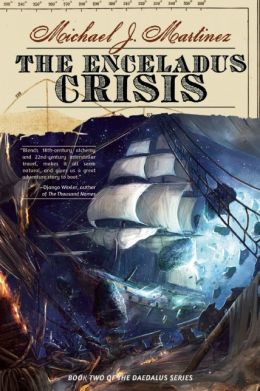Once upon a time, there was an author who wrote a novel. That’s not that strange in the Age of NaNoWriMo, but what’s much more rare is that he actually sold the book. Then, the tale became even stranger, because the author had the great misfortune of seeing his publisher go under just months before his debut novel would be released.
That author is Michael J. Martinez, and the novel, entitled The Daedalus Incident, did eventually see publication when Night Shade Books was acquired by Skyhorse/Start Media. (You can read a longer version of the book’s very odd history, plus my review.) Now, just about a year later, Michael J. Martinez returns with The Enceladus Crisis, the direct sequel to The Daedalus Incident.
Once again, the story is split between two timelines, one set in the year 2134, the other in 1798. What’s more significant, though, is that the 2134 timeline is set in a universe that mostly appears to follow the regular laws of physics we all know and love, while the 1798 story takes place in an alternate universe where sailing vessels can fly through outer space, most planets and moons have a breathable atmosphere, and several races of aliens exist.
The contrast between those two timelines couldn’t be stronger. The future one is unmistakably science fiction, with strong elements of military SF and even some hard SF. The other one mixes Master and Commander-style historical fiction with strange and fascinating pulp SF concepts. And just like in the first novel, the two timelines initially feel like entirely separate novels, but the parallels and connections become more and more apparent as the story progresses.
So, up to now, The Enceladus Crisis sounds like an updated copy of The Daedalus Incident, right? Well, not exactly. There’s one key difference: in the new novel, Michael J. Martinez splits each timeline between two characters, resulting in a total of four separate plots, two in 2134 and two in 1798.
On the plus side, if you’ve read the first novel, you’ll be familiar with all four main characters. Returning from The Daedalus Incident are Thomas Weatherby (in 1798), now captain of the seventy-four-gun Fortitude and chasing an escaped French ship from Egypt to Saturn, home of the strange alien race known as the Xan. Also making a second appearance (in 2134) is Shaila Jain, now Lieutenant Commander of the Joint Space Command (JSC) ship Armstrong, which is en route to Saturn on humanity’s first manned mission.
And then there are the two additional point-of-view characters. The first one is Dr. Evan Greene (2134), who has rejoined JSC as the science lead in a new program meant to defend against other-dimensional incursions: the Dimensional And Extraterrestrial Defense, Analysis & Logistical Unified Services—or DAEDALUS. (Yes, I know.) The second one is Dr. Andrew Finch (1798), one of the finest alchemists in the Known Worlds, who is investigating Napoleon’s forces in Egypt.
Unfortunately, the addition of those two point-of-view characters is not a change for the better. Having four narrators obviously isn’t a problem in itself (as epic fantasy regularly proves), but combined with the novel’s split across two timelines, it does make everything more confusing. The two separate stories in the first book slowly but effectively revealed their connections; the new novel’s four plots become too muddled during this process.
This is especially problematic during the story’s climactic resolution, announced by a scene (at the end of Chapter 18) that practically begs for a dun dun duuuun sound effect. Michael J. Martinez keeps all four story lines moving along, but as he switches the focus from character to character, the tension is sustained for such a long time that The Enceladus Crisis feels a bit exhausting and confusing in the end run.
Still, there’s a lot to love here, especially in the sections of the novel set in 1798, with their odd combination of historical fiction and pulp SF. Even when this results in highly improbable scenes (e.g. when a sword and pistol damage a high tech alien conveyance), it’s never less than entertaining. The dialogue is also much better in these sections: somehow, Martinez makes the formal speech of the historical British characters sound more natural than the future Americans’ colloquial banter.
Even though it has some issues, The Enceladus Crisis is worth checking out, especially if you enjoyed The Daedalus Incident. After all, there aren’t many books out there that manage to move, in just a few pages, from explaining the ultra-dense polymers used in radiation shielding to magic and alchemy. The Enceladus Crisis also sets everything up for a third novel that promises to be spectacular—but I hope Michael J. Martinez won’t continue the trend and follow eight storylines in that one.
The Enceladus Crisis is available now from Night Shade Books.
Check out Michael J. Martinez’s Pop Quiz interview here on Tor.com
Stefan Raets reads and reviews science fiction and fantasy whenever he isn’t distracted by less important things like eating and sleeping. You can find him on Twitter, and his website is Far Beyond Reality.










